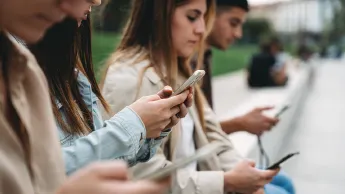Counteracting fake news and populism with an app
- 2024-12-17
- Anna Scheld
- Comment

Chris Brown, Professor of Education at the University of Southampton is a participant of the . With his idea, the Effective Living app, he would like to help people to discover positive ideas, to encourage critical thinking and to question populism and conspiracy theories. His project combines research findings with innovative technology.
Two years ago, Chris Brown went for a little walk in his hometown Southampton in England and noticed how people were dropping their rubbish in the streets. He was perplexed and asked himself, why people would treat the streets that they live on so carelessly.
Responding to present-day crises
“It was a banal moment,” Brown would later say in a video interview, adding that he had been “distressed by the world and all the crises that we have not been able to overcome ever since the Covid-19 pandemic”. Brown felt that people carelessly dropping rubbish in the street was symbolic of what was going wrong in society. Many people do not feel connected to their environment, in his experience, and they no longer tend to care about their community. The popularity of populist parties, distribution of misinformation, the anti-vax movement and conspiracy theories are symptomatic of this, Brown explains. On his little walk across Southampton, Chris Brown decided that he would like to make a difference.
Chris Brown is a Professor of Education at the University of Southampton in the South of England. He has also been a visiting professor at the University of Tübingen since 2021. In 2024, Brown is taking part in the held by Alumniportal Deutschland. His idea: an ideas app called .
Positive inspiration
In his research, Brown has been exploring the question of how humanity can benefit from ideas, for a long time. In recent years, he developed the concept of an “idea-based society”. He makes a clear distinction between positive and dark ideas here, with the former being beneficial and the latter being harmful to us.
Dark ideas lead people to believe in things that are wrong and harmful to them, according to Brown’s concept. People can get lost in these types of idea, while good ideas are just passing them by. Positive ideas, meanwhile, can be helpful in life.
These include ideas for leading a healthier, happier life. Ideas are powerful, and this is true of both the good and the bad ones. On his walk, Brown wondered how he might make people focus on positive ideas. And how he might be able to help them to take a more critical look at ideas and to identify those that are not scientifically sound more quickly.
Results of a representative survey
“I spent a lot of time thinking about how this could be realised in practice,” Brown says: “How do you encourage people to change?” At the time he was using an app to learn Italian, and he continues to use this app to this day. This made him come up with the idea to realise his project by means of an app, since “apps are great for developing habits and networking in connection with a specific topic”.
In July 2024, Brown conducted a representative scientific survey. 7,000 people from seven European countries – Finland, Sweden, Italy, Switzerland, the Netherlands, Spain and the United Kingdom – completed the questionnaire. Based on their responses, Brown wanted to find out to what extent ideas, receptiveness to ideas and analysis of ideas are linked to a person’s level of education, their social environment and their way of thinking.
The results of the survey confirmed Brown’s assumption that people are more likely to come in contact with dark ideas – such as conspiracy theories, populism, etc. – when they have a low level of education, when such ideas play a role in their social milieu, and when they tend to think in the short term. Those are the people that Brown would like to reach with his app.
Exciting ideas, useful tools
“I want the app to present wonderful ideas to them,” Brown says. Planning also provides for the app to include some useful tools that help users to critically examine ideas. The app is designed to help users to learn to ask themselves questions: What assumptions is an idea based on and are these scientifically sound? Is somebody pursuing a particular goal with this? “I want people to examine different ideas through the app, both good and bad ones, and to learn how to tell them apart,” Brown says.
The target group of the app are young people with a low level of education. The education expert wants to reach them, for example, by visiting schools and making teachers aware of the app. “I don’t want the app to use too much text, there will be lots of visual elements,” Brown explains. He also stresses that he does not want his app to be patronising, but a playful way to make suggestions for leading a better life.
Community Challenge: inspiration and motivation
Practical realisation of the app is still outstanding. “I am an academic, not a businessman,” Brown says laughing. He is currently looking for supporters from all areas, such as app development and marketing. He also needs institutions such as galleries or museums that can provide content. Brown mentions that one of the judges of the Community Challenge is currently acting as his mentor, which is very helpful. He also points out that an investor is still needed: somebody who believes in his idea. It has been an enjoyable process, Brown says, adding: “Even if we don’t win, we have already found great support through the Alumniportal.”
